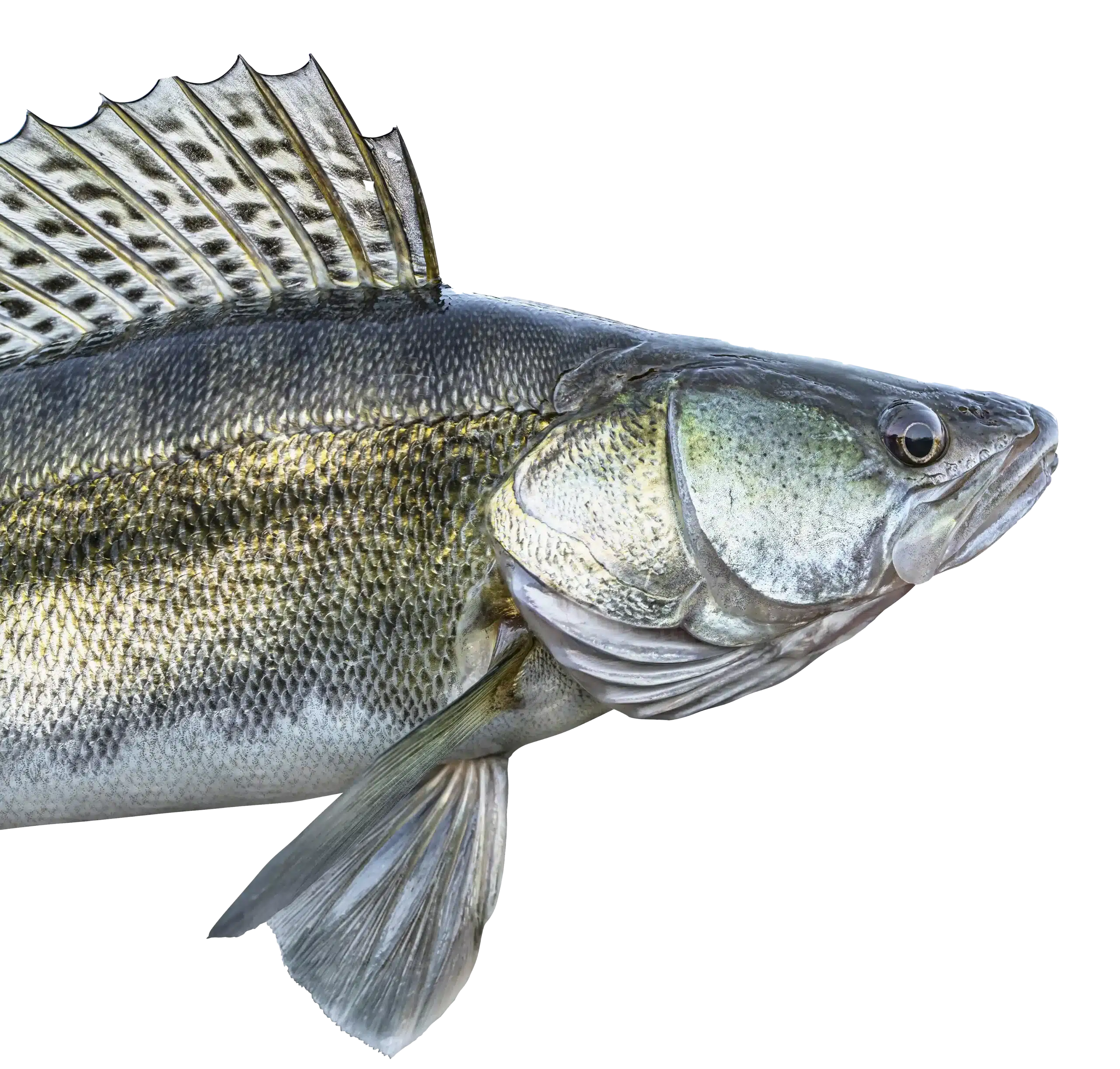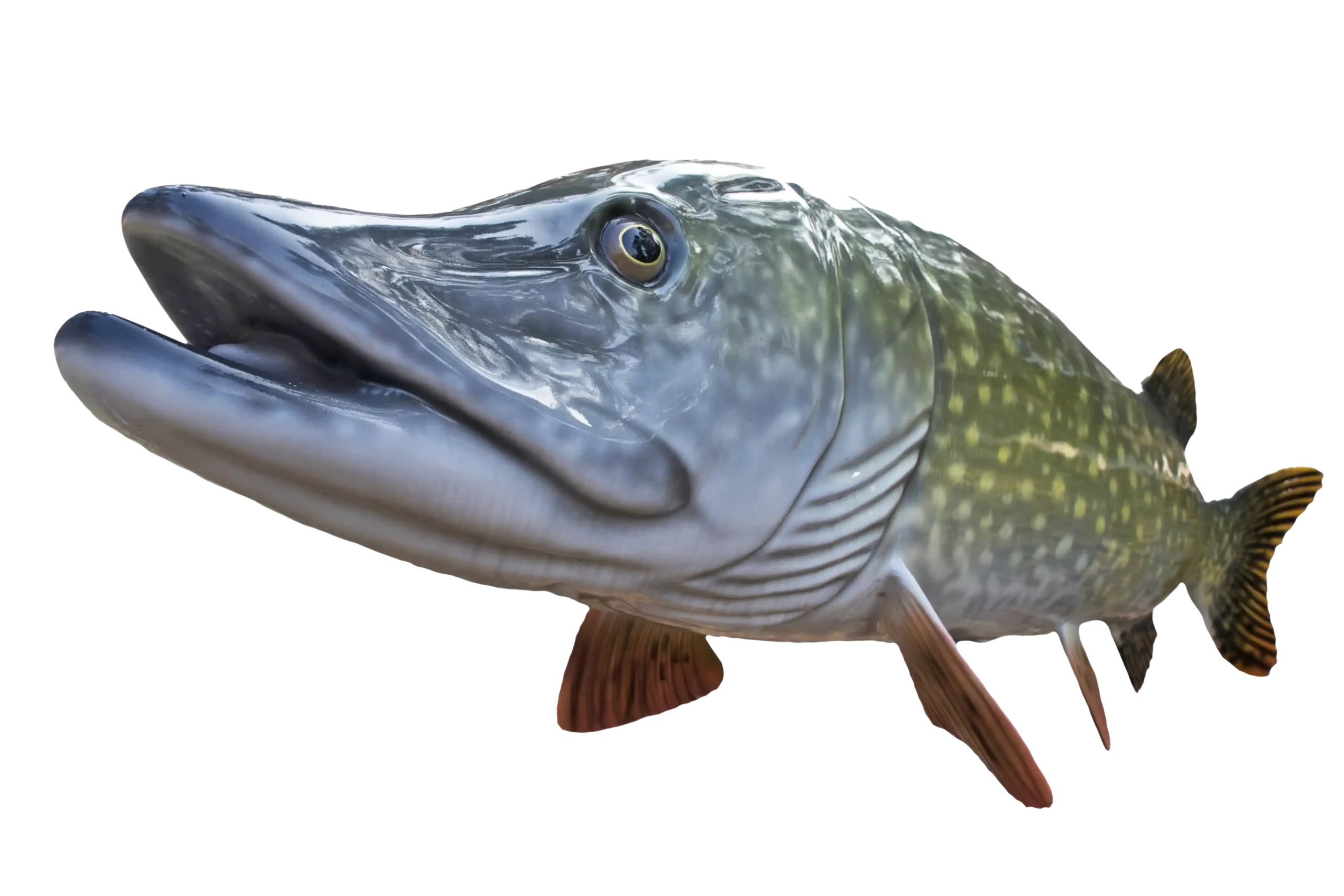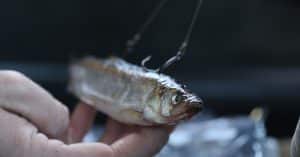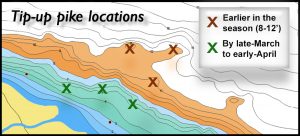

MTT. Minnesota Tournament Trail
NWT. National Walleye Tour
AIM. Angler’s Insight Marketing
Chili Bowl, Border View Lodge
Arnesen’s, Summer Tournament
River Bend Resort, Ladies tournament
Zippel Bay Resort, Northern Pike Tournament
AND MORE!
As we approach March, watching the numbers of big pike being caught on Lake of the Woods, some by pike anglers, some by walleye anglers, it reminded me that this happens every year. Anglers really start to dial into March pike on tip-ups mid to late March into April. With that being said, there is a ton of great pike fishing that happens in February that is under the radar screen.
The other thing interesting is how many big walleyes have been caught this year on tip-ups with big sucker minnows after dark. That’s right, after dark in shallower water. A flash light to shine out of the fish house windows watching for flags when the sun is down is how they do it. Not every walleye is always doing the same thing in the system. Big predators often like big baits.
This reprint of an article from Brett McComas of Target Walleye on catching big Lake of the Woods pike on tip-ups was just too good and educational to let die in the archives.
If you haven’t done it, tip up fishing can be a blast and a fun change from walleye fishing. Resorts on Lake of the Woods will actually place “pike houses” in areas pike are living. Most will use the house as home base and spread tip-ups around watching for flags from the comfort of their home away from home. Enjoy the article.
By Brett McComas, Target Walleye
Known for its zillions of walleyes, Lake of the Woods has also become a world-class pike fishing destination — especially during the Mar/Apr late-ice period. The border waters’ special regulations mean these fish can be targeted all the way through ice-out.
Mammoth pike will stage for the upcoming spawn in shallow bays all along the south shore and are ready to pop tip-up flags. Believe it or not, 40-inchers are hardly considered “big ones” when the bite is on!
Big-fish junkie Andy Walls has been specifically targeting these toothy critters for years, so we tracked him down to get his scoop on putting these freaks topside:
Andy: “You can keep the gear pretty simple when running tip-ups, but make sure to beef things up for those larger-than-average Lake of the Woods gators.”
> “Make sure tip-ups are spinning smooth and that they have fresh 50-lb Sufix Performance Tip-Up Ice Braid. From there a quick-strike rig tied right to the tip-up line, and a 1/4-oz weight fixed above the leader to keep the bait in the strike zone.
“Larger ‘Y yolk’ quick-strike rigs present both live and dead bait really well. They have a solid hook-up ratio with one treble fixed just before the head of the minnow and one rigged right before the tail.”

> “I’ve had the most success using 50-lb wire down to two #2 VMC Hybrid Trebles. However, there’s lots of rigging options out there…recommend using any legal option you’re most confident in.
> “Lake of The Woods has a 30-40″ protective slot, so fish between 30″ and 40” need to be quickly released back into the water. I’ve found that packing a kit — that we bring with to every flag — helps this process immensely.
> “In the kit: We keep extra rigs, sinkers, pliers, jaw spreaders, hook cutters, measuring tapes, fish grippers, a hole scoop, and a camera.
> “Being able to quickly take care of the fish after you land it and get it back in the water will help ensure a healthy release. Also allows us to get accurate measurements and a quick photo before we let them go.”
> “Lake of The Woods northern pike can be caught literally almost anywhere on the lake, but there’s a large concentration of fish that really never leave the south shore.
> “Some of my best success early on in the season is in the 8-12′ range. Look for subtle structure changes like: a slightly quicker depth change, funnel, or ridge the fish may be following. Changes in the bottom content — like a rock or gravel patch — will usually provide even better action.
“As the days start running longer and temperatures begin to inch up, pike will start to migrate in closer to the shorelines. By late March or early April, we’re typically setting lines in less than 5′.

> “Spread lines out to cover as much water as possible — I like walking at least 25-35 steps between holes. The more areas you can eliminate (or find) quickly gets you more bites in a day. Once you settle into an area with fish, they seem to let you know pretty quickly.
> “Not getting bit? Try moving north/south (shallower or deeper) first…when you find the right depth those flags will pop.
> “If I’m getting activity but not getting fish…AKA “false flags”…I’ll make smaller moves east/west or play with my bait (size, type, depth set, etc). Even if it’s the minnow tripping a flag, it’s likely because a pike spooked it and didn’t eat. Dead bait seems to be better when getting a lot of those false flags.”

> “You’re allowed 2 lines each…makes it a little faster to see what’s working! Mix up the depths you set your baits down — covering the entire water column keeps the fish ho
nest. I’ve caught them setting lines just inches below the ice all the way to laying baits right on the bottom.
> “Arming your spread with a mixture of live and dead baits will allow you to quickly figure out what the pike want that day. Alewife, smelt, herring, numerous sizes of live suckers, or even large shiners work well.
> “Pay close attention to which flags are going off: If dead baits are getting more bites…switch more lines over to dead bait. If more flags are going off on a certain side of the spread…start shifting the entire spread in that direction. Can turn a good day into a great day!”
> “Some people like to wait and let the fish eat, but I’ll grab the flag as quick as I get to it and set the hook while they’re running…not stopped. My theory is that anytime the fish is moving, they likely have a good grip on the head or tail of the bait…both have hooks.
> “When they’re not moving, they’re adjusting the bait in their mouth…so you’ll miss half the fish that grab it.
> “Also seem to get much better hooksets when the fish is running — doesn’t take nearly as much force for the hook to penetrate since the fish is already pulling the other way.”
Click Here to access the Lake of the Woods Tourism website
Click Here to access Lake of the Woods area Lodging and Fish House Rentals


Lake of the Woods
We firmly believe that the internet should be available and accessible to anyone, and are committed to providing a website that is accessible to the widest possible audience, regardless of circumstance and ability.
To fulfill this, we aim to adhere as strictly as possible to the World Wide Web Consortium’s (W3C) Web Content Accessibility Guidelines 2.1 (WCAG 2.1) at the AA level. These guidelines explain how to make web content accessible to people with a wide array of disabilities. Complying with those guidelines helps us ensure that the website is accessible to all people: blind people, people with motor impairments, visual impairment, cognitive disabilities, and more.
This website utilizes various technologies that are meant to make it as accessible as possible at all times. We utilize an accessibility interface that allows persons with specific disabilities to adjust the website’s UI (user interface) and design it to their personal needs.
Additionally, the website utilizes an AI-based application that runs in the background and optimizes its accessibility level constantly. This application remediates the website’s HTML, adapts Its functionality and behavior for screen-readers used by the blind users, and for keyboard functions used by individuals with motor impairments.
If you’ve found a malfunction or have ideas for improvement, we’ll be happy to hear from you. You can reach out to the website’s operators by using the following email
Our website implements the ARIA attributes (Accessible Rich Internet Applications) technique, alongside various different behavioral changes, to ensure blind users visiting with screen-readers are able to read, comprehend, and enjoy the website’s functions. As soon as a user with a screen-reader enters your site, they immediately receive a prompt to enter the Screen-Reader Profile so they can browse and operate your site effectively. Here’s how our website covers some of the most important screen-reader requirements, alongside console screenshots of code examples:
Screen-reader optimization: we run a background process that learns the website’s components from top to bottom, to ensure ongoing compliance even when updating the website. In this process, we provide screen-readers with meaningful data using the ARIA set of attributes. For example, we provide accurate form labels; descriptions for actionable icons (social media icons, search icons, cart icons, etc.); validation guidance for form inputs; element roles such as buttons, menus, modal dialogues (popups), and others. Additionally, the background process scans all the website’s images and provides an accurate and meaningful image-object-recognition-based description as an ALT (alternate text) tag for images that are not described. It will also extract texts that are embedded within the image, using an OCR (optical character recognition) technology. To turn on screen-reader adjustments at any time, users need only to press the Alt+1 keyboard combination. Screen-reader users also get automatic announcements to turn the Screen-reader mode on as soon as they enter the website.
These adjustments are compatible with all popular screen readers, including JAWS and NVDA.
Keyboard navigation optimization: The background process also adjusts the website’s HTML, and adds various behaviors using JavaScript code to make the website operable by the keyboard. This includes the ability to navigate the website using the Tab and Shift+Tab keys, operate dropdowns with the arrow keys, close them with Esc, trigger buttons and links using the Enter key, navigate between radio and checkbox elements using the arrow keys, and fill them in with the Spacebar or Enter key.Additionally, keyboard users will find quick-navigation and content-skip menus, available at any time by clicking Alt+1, or as the first elements of the site while navigating with the keyboard. The background process also handles triggered popups by moving the keyboard focus towards them as soon as they appear, and not allow the focus drift outside it.
Users can also use shortcuts such as “M” (menus), “H” (headings), “F” (forms), “B” (buttons), and “G” (graphics) to jump to specific elements.
We aim to support the widest array of browsers and assistive technologies as possible, so our users can choose the best fitting tools for them, with as few limitations as possible. Therefore, we have worked very hard to be able to support all major systems that comprise over 95% of the user market share including Google Chrome, Mozilla Firefox, Apple Safari, Opera and Microsoft Edge, JAWS and NVDA (screen readers).
Despite our very best efforts to allow anybody to adjust the website to their needs. There may still be pages or sections that are not fully accessible, are in the process of becoming accessible, or are lacking an adequate technological solution to make them accessible. Still, we are continually improving our accessibility, adding, updating and improving its options and features, and developing and adopting new technologies. All this is meant to reach the optimal level of accessibility, following technological advancements. For any assistance, please reach out to